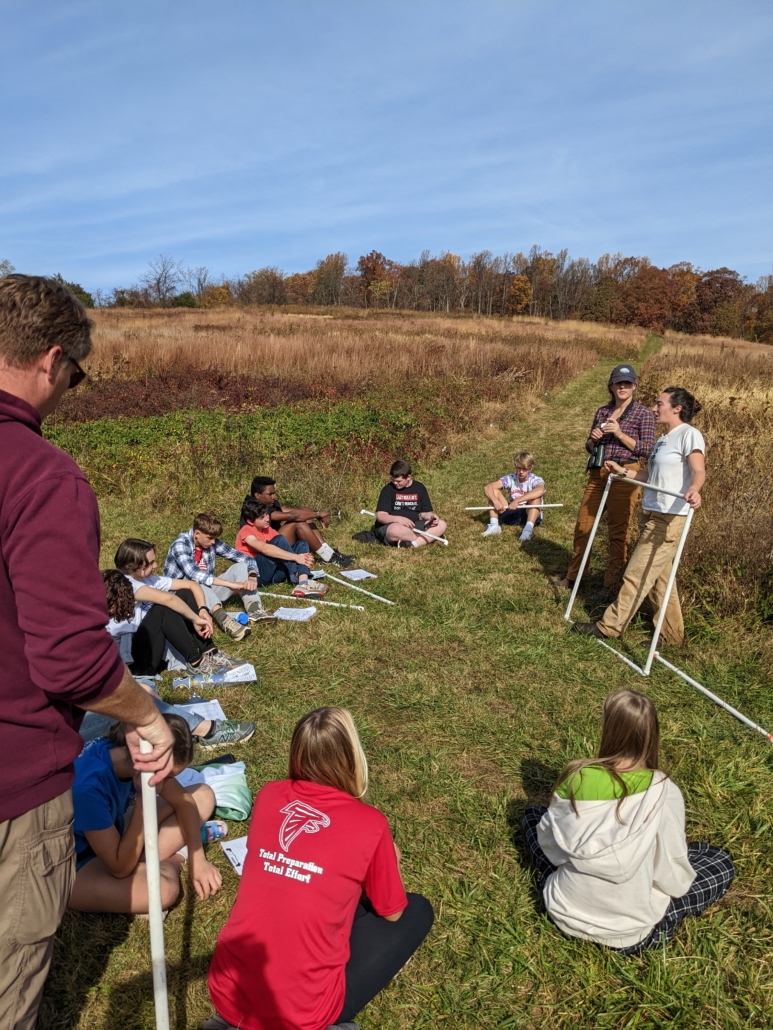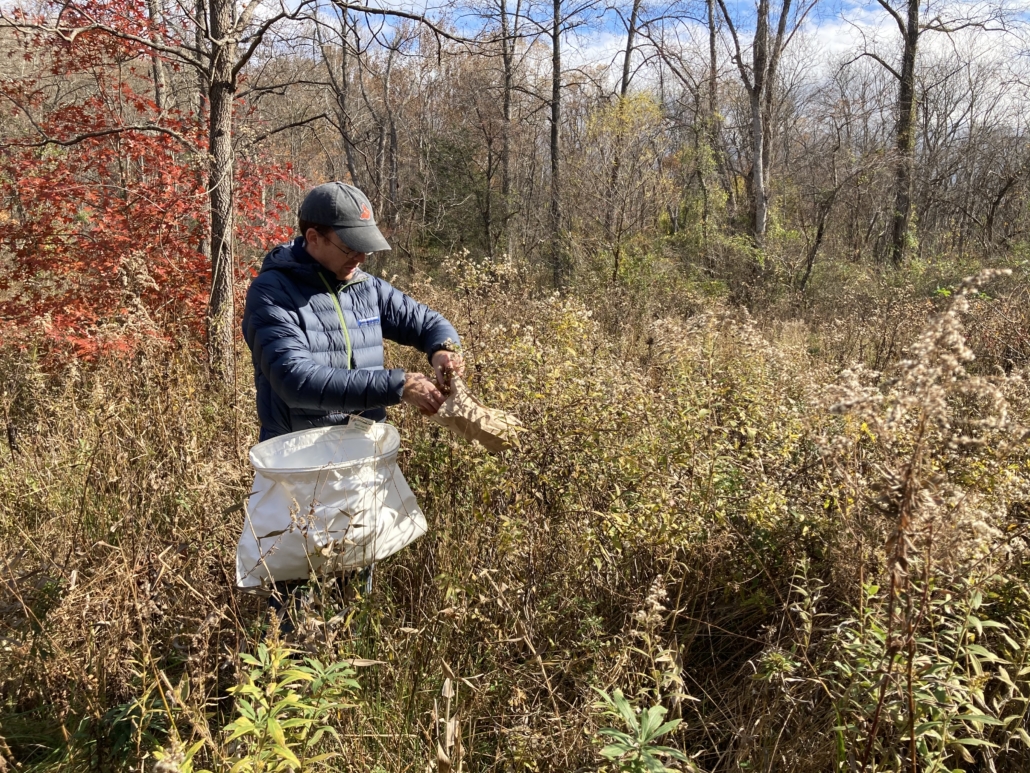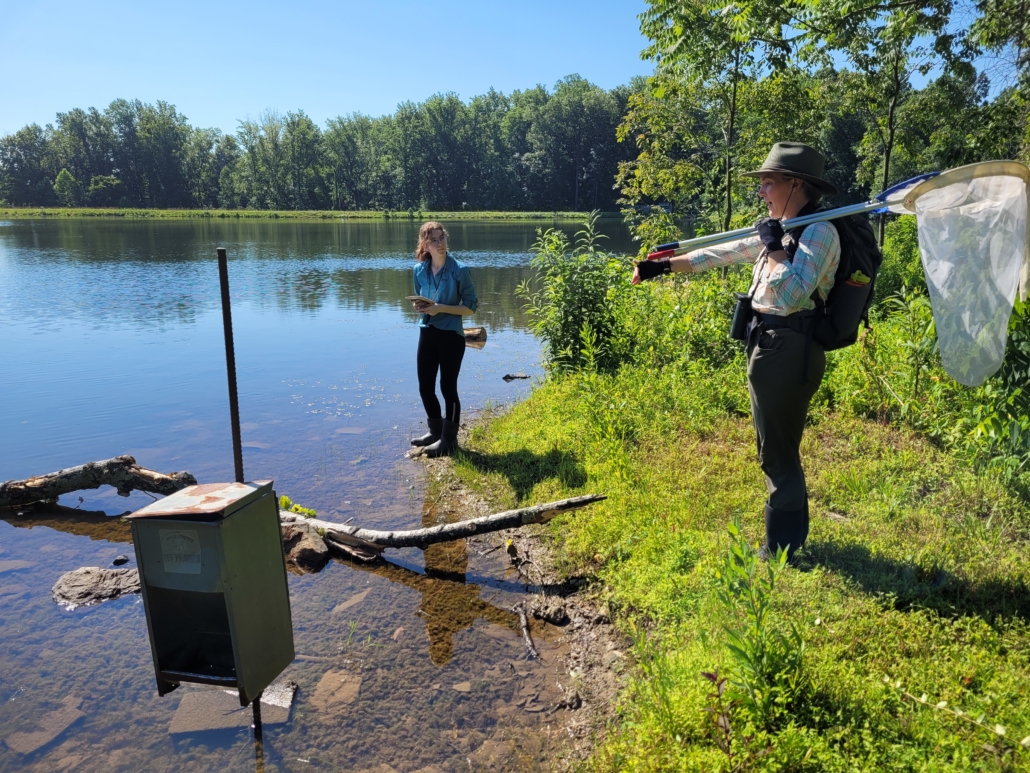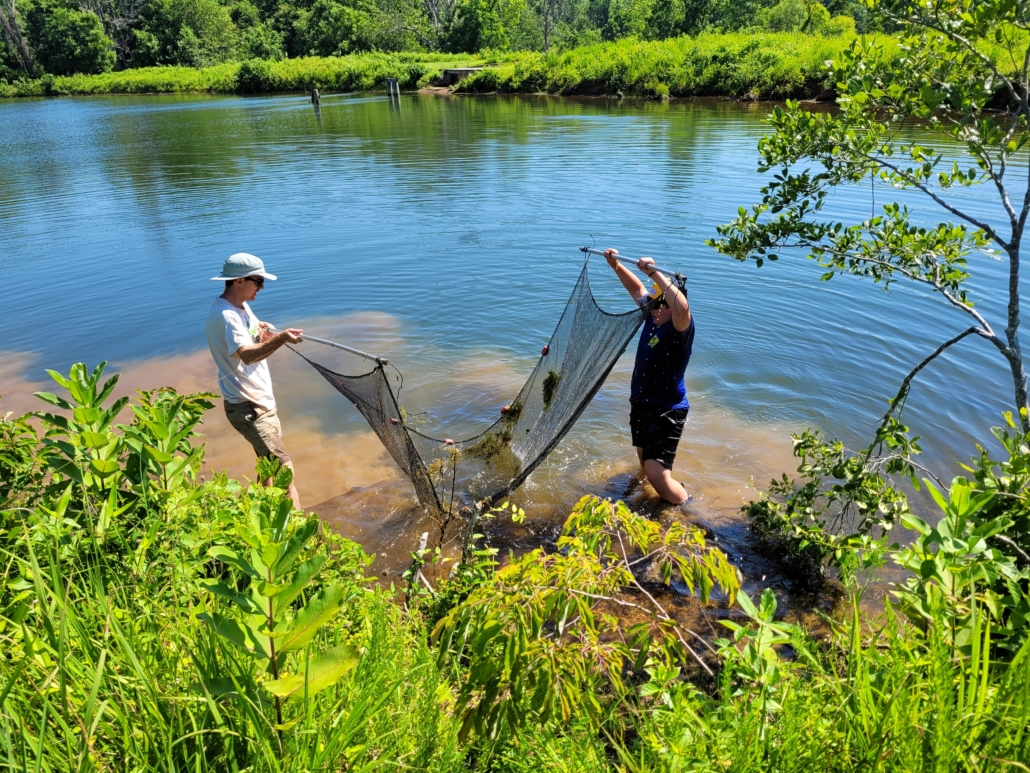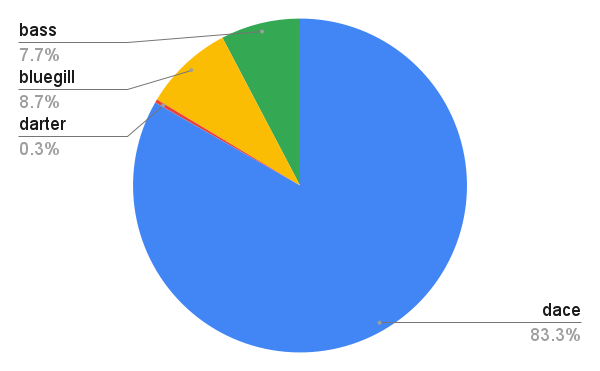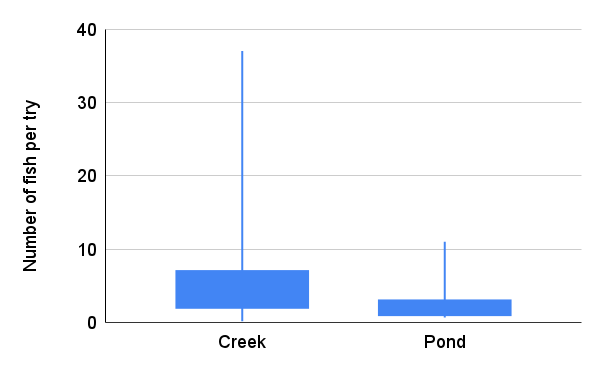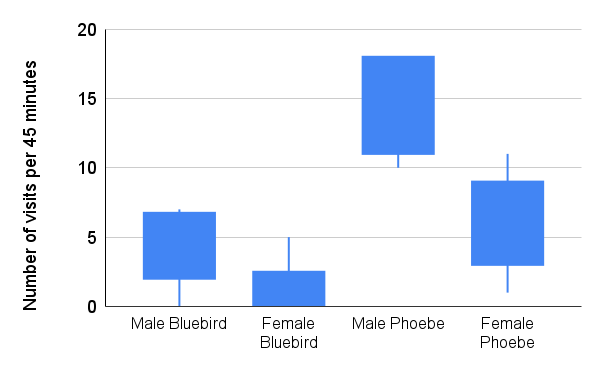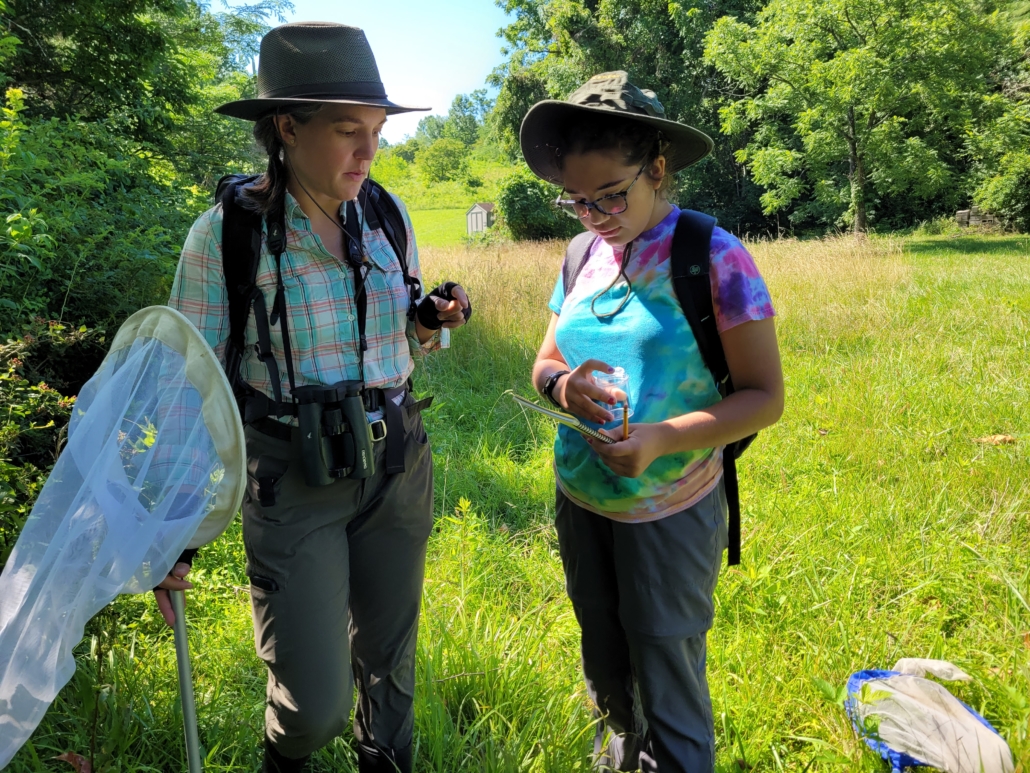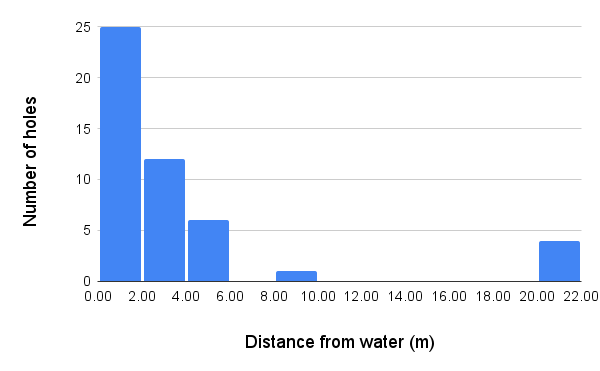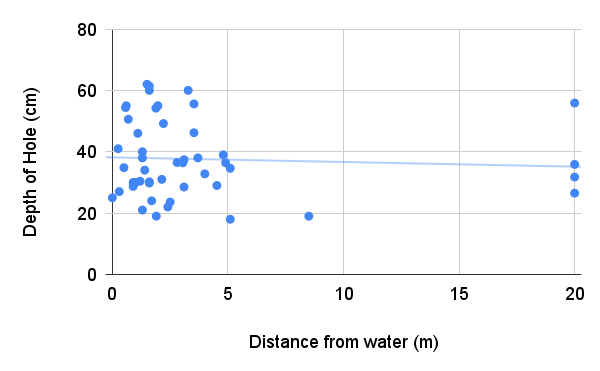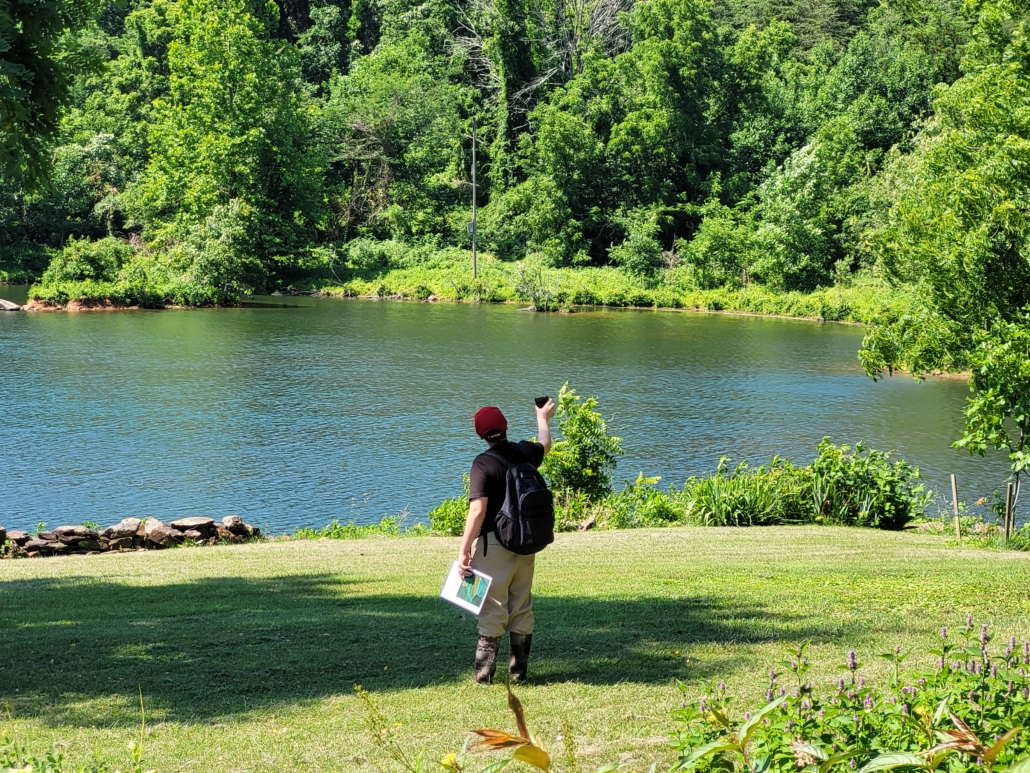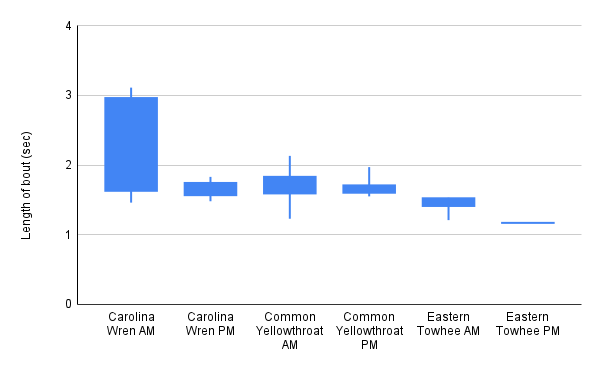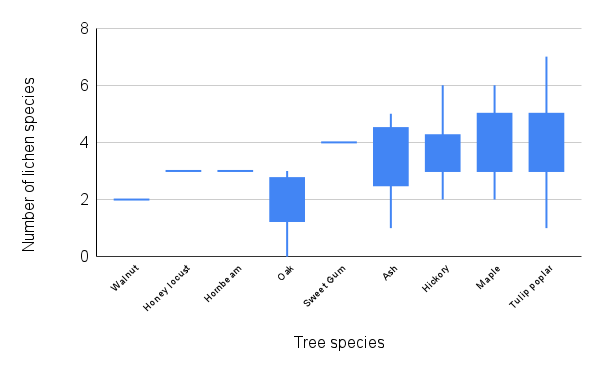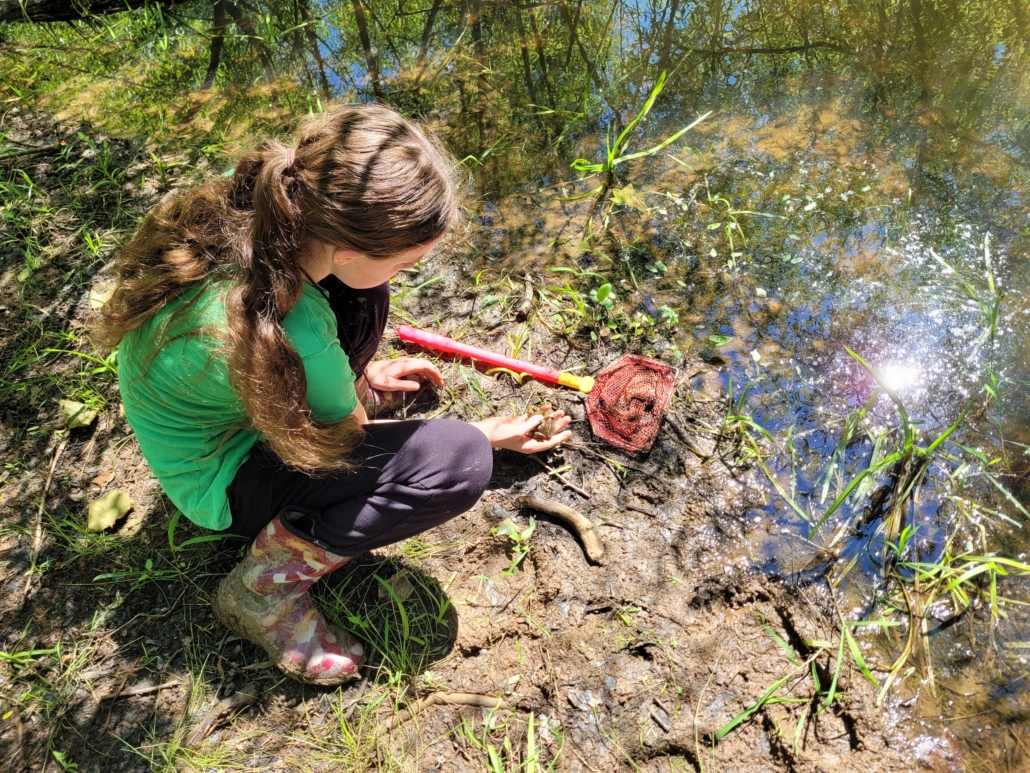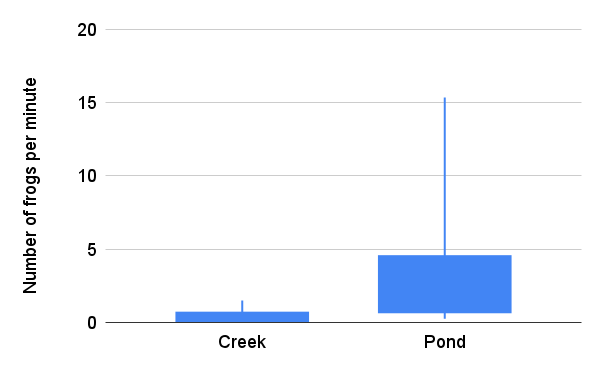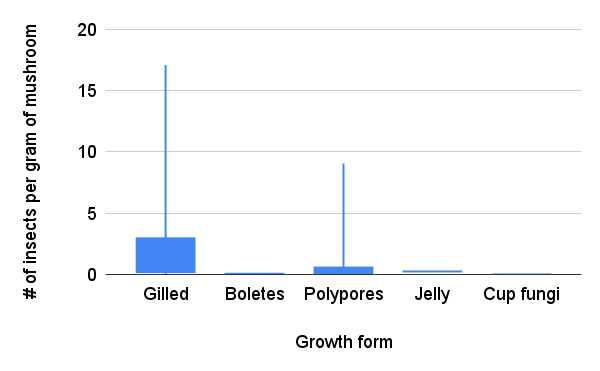Most of us living in Northern Virginia naturally break down our region into sections based on geographic, ecological and cultural similarities. The Blue Ridge Mountains form an undulating wall on our western horizon, clearly visible for many miles as a rugged line of forested mountains. The coastal plain encompasses the lowlands surrounding the Chesapeake on eastward, across the Delmarva Peninsula to the Atlantic, and everything in between we call the Piedmont.
From a strictly geographic point of view, everything below the higher peaks of the Blue Ridge all the way to the coastal plain could be considered the Piedmont, which is defined as a gentle slope leading to the foot of a mountain range. But the Piedmont of Northern Virginia is a diverse landscape that can be a little hard to pin down under one umbrella.
The Piedmont is important. A line of big cities marks its eastern edge. Why? This is where ancient crystalline bedrock first emerges from under the young, low-lying sediments of the coastal plain. Wide, tidal waters easily navigable by cargo ships encounter constricted, fast-flowing streams winding between the rocky hills. Mills requiring high gradient waters for power could load their products right onto big ships and send them across the world.
From an ecological point of view, the piedmont is a land of relatively high biodiversity. A jumble of different bedrock types, spread across a landscape of rolling hills and meandering valleys leads to diverse soils. The Piedmont’s position just below and east of the mountains makes for a milder climate with somewhat higher rainfall than areas just to the west of the Blue Ridge.
When trying to define the Piedmont geologically, things get much murkier. In fact, one could easily make the argument that everything west of a line from Culpeper to Warrenton to Leesburg is actually part of the Blue Ridge Mountains. How is that?
The “Piedmont” in these parts is actually divided into three very distinct regions geologically. To understand that better, let’s look at things in a cross section. Since the whole region is oriented from southwest to northeast, we will start in the southeast and head northwest.
As you travel 17 north from Fredericksburg, you transition from the young, undeformed sediments of the coastal plain to massively deformed crystalline rocks just west of I-95. This is a land of choppy hills, and narrow valleys. The elevation generally runs from 200’ to 400’ above sea level. The rocks under these hills are from the early Paleozoic era, when there was little life on land and the dinosaurs were still 300,000,000 years in the future.
The current hills are the eroded nubs of huge mountains from that time. Many of the rocks came from far away and were smashed onto the edge of the continent as the seafloor was subducted underneath, like how a fallen log will collect rafts of foam from the surface of a river as the water moves underneath. In Northern Virginia, this band of low, rolling hills is part of the Inner Piedmont Province. There is an Outer Piedmont farther south and east in Virginia, but it disappears under the sediments of the Chesapeake to the north.

The rolling hills of the Outer Piedmont with the Blue Ridge Mountains beyond. Between lie the lowlands of the Culpeper Basin. To me this is the most characteristic landscape of the Piedmont.
Just past the community of Morrisville, the landscape changes abruptly. The mostly wooded hills are gone and a flatter landscape of broad agricultural fields opens up. This is the Culpeper Basin. A relatively new addition to the geologic landscape of Virginia. By new, I mean there were dinosaurs walking around, and big trees, but no Atlantic Ocean yet, when this basin came into existence.
The basin is the result of a stretching force on the earth’s crust, opposite the force that pushed the rocks of the Outer Piedmont onto the eastern edge of the continent. The Piedmont rocks started to break free and slide away from the Blue Ridge Mountains during the Triassic period some 230,000,000 years ago. The gap in between was filled with sediments to form a flat basin where lava occasionally flowed across the land. The area would have initially looked like a portion of today’s Great Basin in Nevada and Utah. No major tectonic events have occurred since then and the landscape you see today is basically the work of 200,000,000 years of weathering and erosion sculpting this once dramatic rift basin.

Death Valley is an extensional rift basin in Southern California. The topography is likely similar to what the Culpeper Basin looked like in the Triassic and Jurassic periods with the Blue Ridge on one side and the Inner Piedmont on the other.
Just before you reach Warrenton, the landscape changes again. Hills once again dominate the scene. These hills are somewhat broader and taller than those of the Inner Piedmont. They are the remains of lava flows that occurred more than 530,000,000 years ago. The lava was metamorphosed into the greenstone of the Catoctin Formation. This rock is very resistant to erosion and stands high in ranges like Pignut Mountain, where The Clifton Institute is located, and the Watery Mountains just to the west. If you were to stand on the summit of these hills and look northwest, Catoctin Greenstone would also form the higher ridges on the western horizon. In fact, it used to cover everything in between but has been removed by weathering like a giant ice cream scoop, to reveal even older rocks underneath.

Standing on the Catoctin Greenstone of Wildcat Mountain looking west. Catoctin Greenstone also sits atop the high ridges of Mt. Marshal on the horizon. The whole scene is part of the Blue Ridge Anticlinorium.
The rocks under these mountains originated along the eastern edge of North America before the Inner and Outer Piedmont terranes came crashing in and long before the rifting of the Culpeper Basin. The whole slab of rock between Warrenton and Luray was shoved westward some 60 miles from its original position when Europe and Africa collided with North America, detaching it from its roots deeper in the crust and forming what is called a thrust sheet. The whole unit is called the Blue Ridge Anticlinorium or just the Blue Ridge Province.
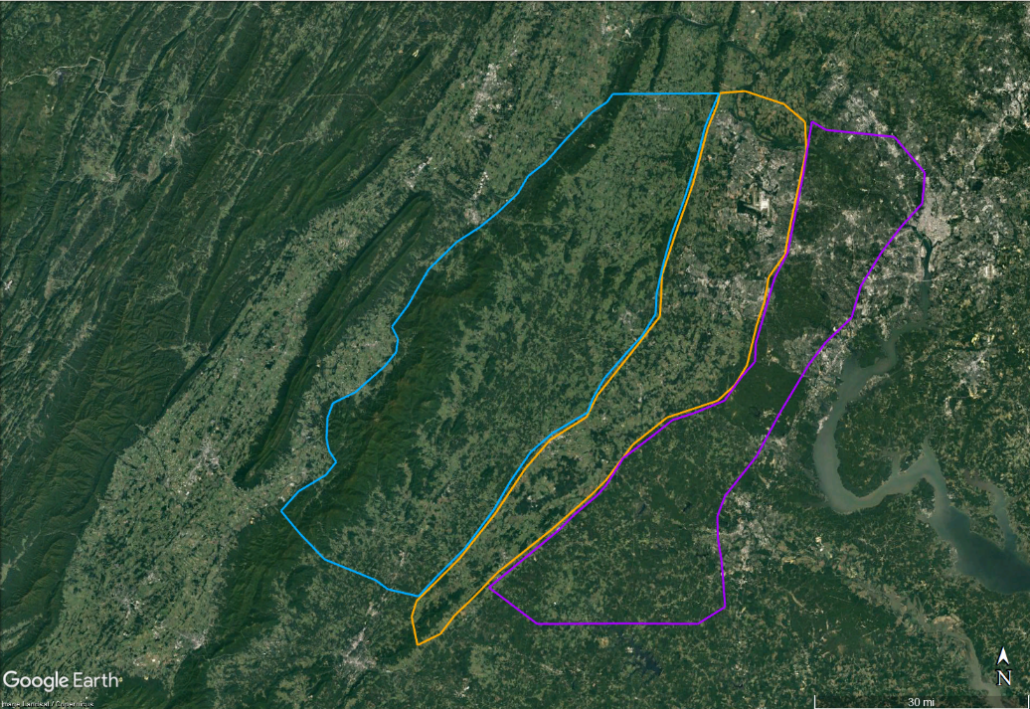
The 3 geologic divisions show up well on satellite imagery. The mostly forested hills of the Inner Piedmont (outlined in purple) are dark green. The lighter swath of farmland and urban development to the west is the Culpeper Basin (outlined in orange), dark areas in the basin are forests covering lava flows where the soil is too rocky for farming. The Blue Ridge Anticlinorium is a mosaic of forested hills and fields bounded on the west by the higher mountains of Shenandoah National Park (outlined in blue.)
(If you’re not familiar with the Native Seed Pilot Project, check out this news release.)
Native Seed Project Coordinator Isaac Matlock joined our staff in October and immediately got to work collecting seeds with the help of partner organizations and several volunteers. We caught up with Isaac to ask him how the collection season went.
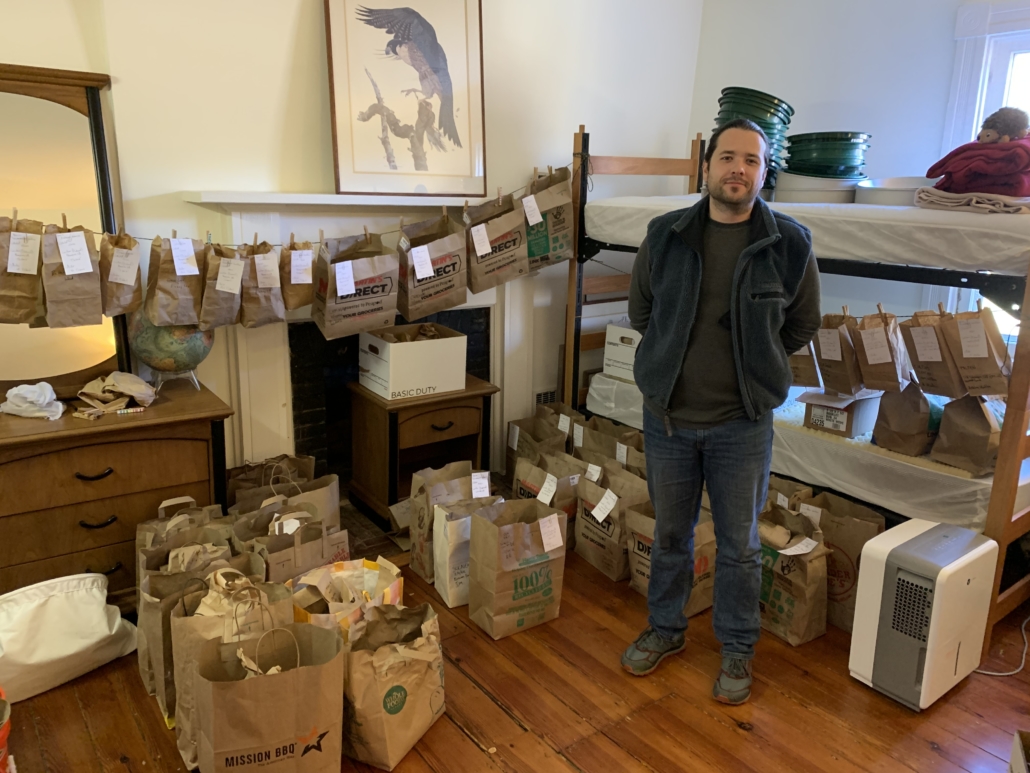
Native Seed Project Coordinator Isaac Matlock standing in front of a portion of the seeds collected this season.
Q: What were your goals for this fall?
IM: Our primary goal was to collect as much seed as possible from the three ecoregions of Virginia (Mountains, Piedmont, Coastal Plain). Our target species for this project are common plants found throughout the state, but in order to ensure we were collecting plants considered Virginia ecotypes we needed to confirm the sites we were visiting had no prior history of seeding or planting that would have come from outside sources.
Another goal this season was to record new sites that could be potential collection areas for future years. By growing our inventory of potential collection sites, we’ll have the ability to collect a larger quantity of seed overall but also reduce our dependence on any given population. Collecting too much seed from one area can be detrimental to the given species and their associated ecosystem. Having as little as possible impact on these places is a vital part of this project.
Q: What is one challenge you faced?
IM: One of the most significant challenges so far in this project has been locating species with populations large enough to sustainably collect seed from. There are many reasons for this challenge, but habitat destruction has the most significant impact. Our goal is to bring these native plants to the seed market in order to make them more widely available in Virginia and introduce a lucrative crop for farmers around the state, but also to ensure the survival of these species for their own sake and for the animals that depend on them. Continued spread of urban development makes things difficult for our state’s biodiversity and collecting these species now will hopefully assist in maintaining healthy populations or, in some cases, reintroducing them to areas that they may have been extirpated.
Q: What went well?
IM: Despite the shortened collection season [because Isaac started in October] and the ongoing search for new collection sites, we were able to collect a considerable amount of seed this year. We managed to collect seeds for sixteen of our eighteen target species.
Additionally, the majority of the seed collected this season came from private land with owners kind enough to let us do so. Many of these landowners were acquainted with the native plants on their land and were excited to contribute to their conservation, while others were excited to learn new things about their property. A project like this provides a great example of the value native plants bring. I believe this can provide people with an elevated appreciation for the natural world outside their front door and aid in long-term conservation of these species.
Q: What’s next?
IM: As we move into winter, we have two priorities for the coming year. With the assistance of farmer advocate organizations, we are working to recruit farmers in the northern Piedmont region that would be interested in incorporating native plants into their current agricultural system. We also have to prepare for plug production in the spring while the seeds are being processed by our partner Ernst Conservation Seeds in Pennsylvania. Clifton will be building a new greenhouse that will be able to produce roughly 18,000 plugs. Once the plugs are ready, we will provide them to farmers at no cost to plant for future seed collection.
Stay tuned for news about our new greenhouse in the next couple of months! And if you are a farmer who would like to learn more about the project please email Isaac at imatlock@cliftoninstitute.org
December 8, 2022
In September of 2022, Education Associate Bridget Bradshaw was standing in the experimental grassland having a conversation with one fifth-grade student about bison husbandry while pulling Swamp Agrimony seeds out of another student’s hair. Students were valiantly thrashing away at the tall vegetation on either side of the trail, diving headfirst into their sweep nets to push the contents into a Ziploc bag. They hoped to find one of the families of Orthoptera they’d spent the last hour learning to identify. Bridget looked at one student’s data sheet on the ground. There was a drawing of an ant and something that was maybe a spider. Next to that, a few big zeros, despite the many grasshoppers hopping just out of reach of the nets.
Bridget gently ended the bison conversation and yelled “last sweep and then we head back!” The students let out mixed cries of relief and disappointment. On the hike back to the peach house, the group wondered: Why didn’t we catch any grasshoppers? Bridget was dreading analyzing the data, worried that the kids would feel like they had failed. This was the first time Bridget had run this field trip, which had been redesigned to let students actively participate in ongoing research at Clifton. But there are very few manuals for designing research methods for large groups of students that range in age from kindergarten to 12th grade and may have little to no field experience, and even Bridget, an experienced educator, wasn’t quite sure what to expect. So why redesign the field trips at all?
Dr. Bruce Alberts, a prominent biochemist and recipient of the 2014 National Medal of Science, published a letter in January, 2022, titled “Why Science Education is More Important than Most Scientists Think.” He writes, “providing a quality education for a nation’s youth is perhaps the most important task that confronts a society, but to do it well is an enormously complex task.”
One of the goals outlined in his letter is to make the logic of science—observation, question, hypothesis, evidence collection, analysis, critical discussion, and sharing of results—so familiar to people that it is used in all parts of life in order to make smart decisions. Many studies have found that actively participating in science coupled with interactions with scientists lead to feelings of increased competency and positive feelings towards science in all ages of people (Bonney et al. 2009). A research field station like the Clifton Institute is an ideal venue to provide authentic science experiences to local communities because 78% of people in the U.S. live within 60 miles of a field station (Struminger et al. 2018). And this is why, in the spring of 2022, Bridget, Co-Director Eleanor Harris and Education Fellow Jacob Ewert sat down to re-write Clifton’s field trip curriculum.
The goal was to design field trips that were not only adjusted to reinforce the state standards expected for each grade level, but to engage each of our 1000-plus annual K-12 students in real science, help them use their data to make real land management suggestions, and then share the trials and errors with other field stations looking to improve their science outreach. Which brings Bridget back to the grassland, covered in seeds, zeros in hand, kids in tow.
Students on this field trip were seeking an answer to the question: “does fire affect the abundance of orthopterans in our experimental grassland?” We want to know because American Kestrels, the tiny falcons whose numbers are declining across the U.S., eat a lot of grasshoppers and other large insects, and nobody has studied the possible effects of different management strategies on prey populations.
The students had split into three groups to survey. Individually they only found a tiny handful of grasshoppers, but they concluded that there were more orthopterans on the mowed side. They wondered about what could explain their findings. Did grasshoppers really only eat grass and there were more grasses on the mowed side? Did the burned side have more blackberry bushes that caught the nets and let the grasshoppers escape capture?
Finally, the three small groups compared data. All three graphs showed the same pattern: higher numbers of orthopterans in the mowed section. The students acknowledged that, given they were only surveying for 40 minutes, this might not be an immutable truth, but still—how amazingly consistent given the new method and a field crew that had been trained just an hour prior!
There’s untapped power in bringing students to a research field station and enlisting them as the field crew for the day. They learn that each tidbit of information gained about the world is paid for in sweat and sometimes blood (the grassland is a thorny place), and they learn that understanding how those “facts” came to be is important in deciding how much weight to place on them. Our hope is that each year going forward, classes will return to watch the landscape change and see the power of compounding data to find patterns in plant communities, vernal pools, wintering waterfowl, the onset of spring, and, of course, grasshoppers because most meaningful discoveries—and certainly the kinds that take decades or centuries to see—are the work of many.
Alberts B. 2022. Why Science Education is More Important than Most Scientists Think. FEBS Letters 596: 149–159.
Bonney R, Ballard H, Jordan R, McCallie E, Phillips T, Shirk J, Wilderman CC. 2009. Public Participation in Scientific Research: Defining the Field and Assessing Its Potential for Informal Science Education. A CAISE Inquiry Group Report. Online Submission.
Stuminger R, Zarestky J, Short R, Lawing AM. 2018. A Framework for Informal STEM Education Outreach at Field Stations. BioScience 68: 969-978.
WARRENTON, VA (Sept. 23, 2022) — The Clifton Institute is pleased to announce it has received a Conservation Innovation Grant from the USDA Natural Resources Conservation Service to fund a new program called The Virginia Native Seed Pilot Project. This project will launch the native seed industry in Virginia, which will make it possible to plant ecologically appropriate wildflower meadows.
There is substantial demand for seeds of native wildflowers and grasses for pollinator friendly solar installations, meadow plantings, and roadside revegetation in Virginia. But seeds of several species of plants that are common in native grasslands in the state, and beneficial for pollinators, are unavailable from seed companies. Furthermore, seeds of most species that are available have out-of-state genetics, which limits their utility to restore plant communities and provide pollinator habitat. These plants often bloom at the wrong time for our local insects or they’re too tall or too short.
“Native plants, especially native plants with local genetics, are crucial for supporting native insects, birds, and other wildlife,” says Clifton Institute Executive Director Bert Harris. “Not being able to buy the seeds of plant species native to Virginia, let alone from Virginian populations, is a critical obstacle to creating pollinator habitat statewide.”
The grant will fund a new Native Seed Coordinator position at The Clifton Institute. The Native Seed Coordinator with work with partners and volunteers to collect seeds of 15 species of wildflowers and grasses across the state. A new greenhouse at the Clifton Institute will also be partly funded by the grant and seedlings will be grown to then be transplanted in farmers’ fields. Virginia State University and Clifton Institute staff will work to establish a network of local producers who can serve as a commercial source of native seeds. In particular, the project will focus on equipping underserved farmers with the tools and skills they need to grow and sell this new high value crop. Other key partners in the project are the Virginia Dept. of Conservation and Recreation, Virginia Dept. of Wildlife Resources, the Nature Conservancy, Ernst Conservation Seeds, and the Capital Region Land Conservancy.
(This story originally ran in our email newsletter. Keep up to date with wildlife sightings, programs, news, events, and more by signing up at the bottom of this page!)
Like most things worth doing, land management is tricky. Strategies often have to take into account the fact that invasive species and valuable native species are growing in close-quarters. Budget (both time and money), aesthetics, and wildlife can also be complicating factors, so improving habitat on your property can seem daunting. That’s where the Clifton Institute’s Land Management Outreach Associate Marie Norwood comes in!
In addition to helping manage habitat on the Clifton property, Marie travels to visit private landowners and managers of public land to advise about land management for the benefit of native plants and animals. She helps landowners identify native and non-native plants and declining animals, and she helps people prioritize management actions.
Marie joined the staff in March, 2021. She has a B.Sc. and B.A. from McGill University, where she majored in Organismal Biology and International Development. After graduating, she worked in Colorado conducting terrestrial ecosystem monitoring for the Bureau of Land Management, and in Georgia as a prescribed fire crew supervisor for the Georgia Department of Natural Resources.
“My favorite parts of my first two jobs out of college were the plant science and ecological restoration themes, so this job seemed perfect,” Marie said. “I also liked the idea of communicating ideas which are normally confined to academia and public land managers to private landowners.”
The Clifton Institute’s specialty is meadows, but Marie also advises on shrublands, forests, and anything related to native species and habitat. She spends a few hours on site with an interested landowner, helps them identify the changes they want to make to their property, and then works with them to come up with a plan to make those changes happen. She includes a written report summarizing the visit, and can help connect landowners to a network of resources and partners.
“These things take a long time and a fair amount of effort,” Marie said. “But in a positive light, any little change is the right direction. There will be little victories, and the sooner you start the sooner you will start to see progress.”
Since the program is still in its early stages, Marie generally travels to properties within an hour of Warrenton, Va., but there’s no charge for her assistance, and she’s happy to be a continuous resource for landowners who have questions after the initial visit.
Marie’s favorite part of her job is meeting landowners (and their pets!). “It’s a major source of hope to me that so many people care deeply about these issues and are willing to take time out of their days to talk about habitats and biodiversity,” she said.
If you’d like to request a free property visit from Marie, please contact her at: mnorwood@cliftoninstitute.org
(This story originally ran in our email newsletter. Keep up to date with more wildlife sightings, programs, news, events, and more by signing up at the bottom of this page!)
On June 17, Education Associate Bridget Bradshaw spotted an odd insect. It had an oblong black body, long antennae, and clear wings. It looked like a wasp-moth hybrid, which turned out not to be far off! The insect Bridget saw was a Synanthedon richardsi, which is a rare member of the clearwing moth family Sesiidae.
We wanted to learn more about this beautiful and apparently rare moth so we contacted THE expert on these insects. William Taft is an aquatic entomologist who is one of few people studying the Sesiidae family in depth, and he was kind enough to speak with us more about these mysterious insects.
Synanthedon richardsi was first described in 1946. In 1988, more details were published on clearwing moths in a volume of the Moths of America North of Mexico. According to this publication, Synanthedon richardsi ranges from Maryland to Georgia and west to Ohio and Kansas, but it is rare and “nothing definite is known about its life history.”
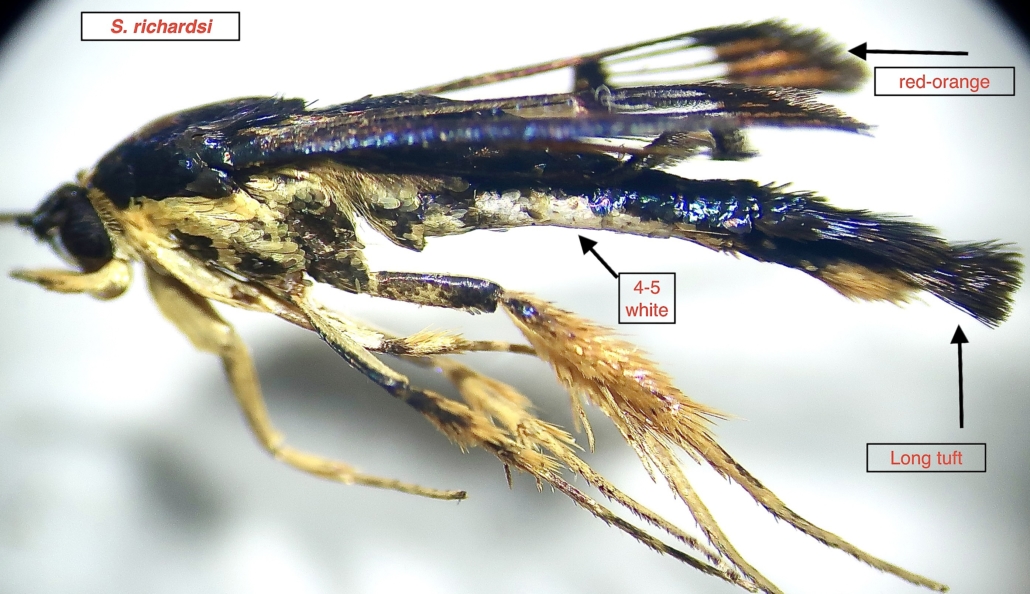
A photo of Synanthedon richardsi with field marks for identification. Photo courtesy of William Taft.
Since 1988, not much more has been learned about this elusive insect, but Taft is determined to change that.
“People are interested in the family, but not that interested,” Taft said. “People are generally more interested in silk moths and hawk moths. But I collected those as a kid, so there weren’t any more mountains to climb there for me. As far as I know, I am the only person in the U.S. actively seeking these things by driving across the U.S. and trying to figure out when and where they emerge.”
Clearwing moths range from just five millimeters up to a wing length of 28 millimeters. They are accomplished mimics of wasps and bees mainly due to their clear wings, but some clearwing moths in the western U.S. have been observed mimicking wasp behavior to complete the illusion. Their caterpillars feed on herbaceous plants, including the trunk, crown, root, stems, seed pods, and even galls. They’re generally short-lived as adults, likely only surviving for a week after emerging. Many clearwings can pose a threat to agricultural plants (an infamous relative of Synanthedon richardsi is the Squash Vine Borer (Melittia cucurbitae)) but they also provide food for anything that includes insects in their diet.
Synanthedon richardsi seem to prefer viburnums as food plants. Our sighting was near a Blackhaw Viburnum, but Taft also described a sighting in South Carolina that was near Walter’s Viburnum.
Taft’s main focus is trying to locate and collect clearwing moths so he can sample their DNA and develop better genetic markers for distinguishing between species.
“If you have multiple species feeding on oak, which a lot of them do, and you want to know if they’re actually distinct species, well, a lot of them look very similar so the only way you can tell the difference is color, flight period, or which synthetic pheromones they come to,” Taft said.
Taft relies on help from users on websites like iNaturalist and Bug Guide to help him with his search. When someone posts a photo of a clearwing moth, Taft notes the date of the photo and the location it was taken, which will help him narrow down the best times and places to look for the insects he wants to collect.
“If no one looks, no one finds,” Taft said. “That’s always been an issue. There aren’t as many people these days, except hunters and fishermen, who are really out in the woods. If it doesn’t happen in their backyard or along a hiking trail, it gets missed. But that’s where people out taking pictures really come into their own.”
We think this is a great example of how much there is still to learn about the natural world, and how close to home these discoveries can happen! If you’re on iNaturalist, we encourage you to join our biodiversity inventory project and submit observations from the property. We have contributed four records of these rare moths so far!
From June 27 to July 1, 2022, nine middle and high school students attended our fourth annual Young Scientists Research Experience. Over the course of a week, the students chose their own research questions, developed a study, did their own fieldwork, and then compiled their data and presented their findings. We’re incredibly proud of the work these students did, and we’re excited to share their results with you!
If you’d like to sign up for next year’s Young Scientist Research Experience, you can subscribe to our email newsletter to be notified when registration opens.
Maggie asked: “Does the size and location of a log affect the number of insects and turtles basking on it?”
She found that both damselflies and dragonflies prefer to perch on skinny logs than wide logs, even though wide logs would provide more surface area. She also found that in general damselflies are pickier about the locations where they are willing to perch than are dragonflies.

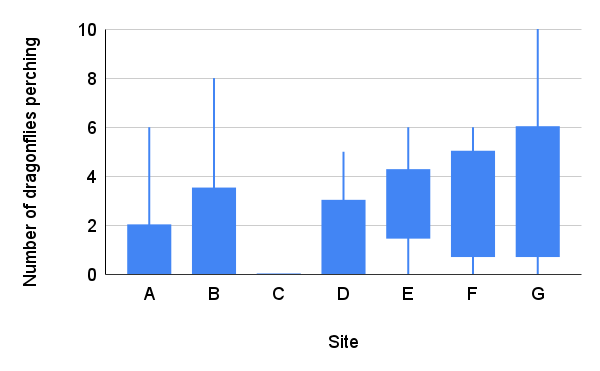
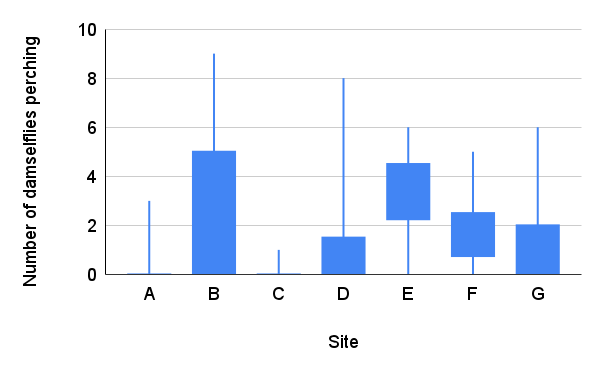 Liam asked: “What species of fish live in ponds compared to creeks? And are there more fish in ponds or in creeks?”
Liam asked: “What species of fish live in ponds compared to creeks? And are there more fish in ponds or in creeks?”
Liam surveyed fish in our ponds and streams and found four types of fish: dace, darter, largemouth bass, and bluegill. The vast majority of the fish he found were dace. Liam caught more fish per sweep of the seine net in the creeks than in the ponds.
Sarah asked: “How do the parenting behaviors between Eastern Phoebes and Eastern Bluebirds differ?”
Sarah found that Eastern Phoebes were more attentive parents than Eastern Bluebirds and in both species the males were actually more attentive than the females. Parents of both species were less active in the afternoon than in the morning.
Aurelia asked: “Where do fireflies go during the day?”
Aurelia found five genera of fireflies in her daytime firefly surveys. Most of the fireflies she found were in the genus Photinus. Of the fireflies she found on trees, most of them were on redbuds, followed closely by walnuts and pawpaws.
Declan asked: “How far away from water do crayfish burrow? And does the distance from water affect how deep the burrow needs to be?”
Declan found crayfish holes at a wide variety of distances from standing water. A couple holes were over 20 meters from water! Surprisingly, there was no relationship between how deep a hole was and how far away from water it was.
Logan asked: “How does the length of birdsong vary between species? How does the time of day affect the length of the song?”
Logan found that, of Carolina Wrens, Common Yellowthroats, and Eastern Towhees, Carolina Wrens had the longest songs and that all three species had longer songs in the morning than in the afternoon.
Lane asked: “Does lichen diversity change as you get closer to water?”
Lane found that there were slightly more species of lichens on trees closer to water than farther from water. Of the nine species of trees he found lichens on, Tulip Poplars had the most species of lichen.
Loreli asked: “Do frogs prefer still water or running water?”
Loreli found that there were more frogs in the ponds than in the creeks.
Elyssa asked: “Does the growth form of a mushroom make a difference in the number of bugs found on them?”
Elyssa found that there were more insects on gilled mushrooms than on any other growth form (after controlling for the weight of the mushroom).
Inspiring students to become future river stewards
Warrenton, Virginia (November 15, 2021) — We are pleased to announce our participation with the Friends of the Rappahannock (FOR) on a grant FOR was awarded from the National Oceanic and Atmospheric Association (NOAA). The goal of their grant is to implement a sustainable Meaningful Watershed Educational Experience (MWEE) program over three years in Culpeper and Fauquier County Public Schools. The grant supports NOAA’s mission to expand environmental literacy through the Chesapeake Bay Watershed Education and Training (B-WET) program. The Clifton Institute will participate by hosting a teacher-training workshop in summer 2022.
“Every year, hundreds of school children visit our property to learn about Virginia’s plants and animals, but we don’t usually get to spend a lot of time with their teachers,” says Dr. Eleanor Harris, Managing Director The Clifton Institute. “We’re excited to work with Friends of the Rappahannock to teach teachers about watershed conservation and about how to engage their students with this important issue.”
FOR’s new Upper Rappahannock Educator Manager, April Harper, will be working with local partner organizations like Clifton Institute as well as teachers and public school staff to integrate MWEEs into the schools. For more information about the Upper Rappahannock B-WET program, you can email April Harper at april.harper@riverfriends.org. If you are interested in learning more about MWEE programs watershed wide, contact FOR’s education team education@riverfriends.org or visit riverfriends.org.
# # #
The Clifton Institute is a Northern Virginia-based non-profit whose mission is to inspire a deeper understanding and appreciation of nature, to study the ecology of our region, to restore habitat, and to conserve native biodiversity. We provide environmental education to people of all ages, carry out ecological research, and restore habitat for native plants and animals. Our 900-acre property in central Fauquier County, which is permanently protected under a conservation easement, provides a beautiful and easily accessible environment for our programs. For more information, visit cliftoninstitute.org, like us on Facebook and follow us on Instagram.
There’s something for everyone at Clifton Institute.
Warrenton, Virginia (October 12, 2021) — Clifton Institute offers an expanded and diverse array of Fall programs for all ages. Each environmental education program is designed to be fun, engaging, and educational so that everyone leaves knowing a little bit more about the amazing plants and animals that call the Virginia Piedmont home.
Children can attend biweekly Nature School classes, Afterschool Adventures (new this year!), become a member of Nature Club, Piedmont Polliwogs, or come on a class trip with their schools. Adults and families can look forward to attending talks, walks, and workshops about wildflowers, native plants, raptors, nature journaling, and more.
-
After-school Adventures is the newest program being offered to students in grades 3-8 on the third Tuesday of each month. Activities will vary each month but will include science projects, art projects, and lessons in outdoor skills.
-
Nature Club meets on the first Saturday of each month and is especially designed for students in grades 6-12. Students will explore Clifton’s 900-acre field station, learn about local plants and animals, all while making new friends with others who love nature.
Monthly Hikes with a Naturalist, Family Nature Walks, and Bird Walks will appeal to adults and families alike. You can even zoom into one of the “OctoBIRD Fest” online discussions to learn about winter bird identification and the physics of bird songs. Many programs are free; others have a small fee with discounts offered to “Friends of the Clifton Institute,” which you can become with an annual donation of just $40.
Clifton Institute staff and volunteers work hard throughout the year, but especially in the fall and winter. Volunteers are always welcome to help teach, remove invasive species, cut back overgrown vegetation, and conduct prescribed burns. In October, there’s something going on every Saturday for anyone who wants to help. You might see migratory birds as well as all sorts of native plants in their autumn colors. Anyone interested in participating in one of the many events or in becoming a volunteer can sign up at cliftoninstitute.org/events.
# # #
The Clifton Institute is a Northern Virginia-based non-profit whose mission is to inspire a deeper understanding and appreciation of nature, to study the ecology of our region, to restore habitat, and to conserve native biodiversity. We provide environmental education to people of all ages, carry out ecological research, and restore habitat for native plants and animals. Our 900-acre property in central Fauquier County, which is permanently protected under a conservation easement, provides a beautiful and easily accessible environment for our programs. For more information, visit cliftoninstitute.org, like us on Facebook and follow us on Instagram.



